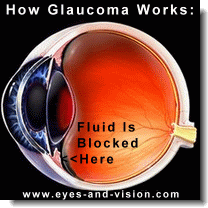
Most cases of Glaucoma can be treated with eyedrops and occasionally oral medication. Should these methods be unsuccessful, laser or conventional surgery can be effective.
Treating Glaucoma With Eyedrops:
The most common eyedrops used for Glaucoma today are the "beta blockers". Usually used twice a day, they are called beta blockers because they block the beta receptors of the sympathetic nervous system. First introduced in the late 70's, beta blockers (such as Betagan, Betoptic, and Timoptic) reduce pressure without some of the side effects produced by other glaucoma eye drops. They do, however, have their own set of side effects. They can make asthma and irregular heart rhythms worse in people who already have these conditions. In some cases, they can even cause emotional problems such as depression.
The most common eyedrops used for Glaucoma today are the "beta blockers". Usually used twice a day, they are called beta blockers because they block the beta receptors of the sympathetic nervous system. First introduced in the late 70's, beta blockers (such as Betagan, Betoptic, and Timoptic) reduce pressure without some of the side effects produced by other glaucoma eye drops. They do, however, have their own set of side effects. They can make asthma and irregular heart rhythms worse in people who already have these conditions. In some cases, they can even cause emotional problems such as depression.
Treating Glaucoma With Oral Medication:
Some pills and capsules, such as Neptazane, Daranide, and Diamox, are effective in reducing eye pressure by reducing fluid production. They are used if a patient cannot use eyedrops, or if more medication is required. Like the eyedrops, these medications also have side effects. They can cause tingling or numbness in the toes or fingers, drowsiness, loss of appetite, mental confusion and/or kidney stones. Despite their side effects, the benefits these drugs provide far outweigh their risks.
Some pills and capsules, such as Neptazane, Daranide, and Diamox, are effective in reducing eye pressure by reducing fluid production. They are used if a patient cannot use eyedrops, or if more medication is required. Like the eyedrops, these medications also have side effects. They can cause tingling or numbness in the toes or fingers, drowsiness, loss of appetite, mental confusion and/or kidney stones. Despite their side effects, the benefits these drugs provide far outweigh their risks.
Treating Glaucoma With Surgery:
While most glaucoma can be controlled with the drops or medication, it is sometimes neccessary to perform surgery as a last resort, using lasers or conventional methods. In terms of conventional surgery, many "filtering operations" have been developed to treat glaucoma. Most of these work by opening up a new drainage channel so the built-up fluid can drain out of the eye. New advances in laser surgery have reduced the need for conventional surgery. Now the surgeon places a special lens on the eye. Inside this lens is a mirror which reflects the laser onto the trabecular meshwork. The surgeon uses the laser to burn a number of microscopic laser spots on the meshwork itself.
While most glaucoma can be controlled with the drops or medication, it is sometimes neccessary to perform surgery as a last resort, using lasers or conventional methods. In terms of conventional surgery, many "filtering operations" have been developed to treat glaucoma. Most of these work by opening up a new drainage channel so the built-up fluid can drain out of the eye. New advances in laser surgery have reduced the need for conventional surgery. Now the surgeon places a special lens on the eye. Inside this lens is a mirror which reflects the laser onto the trabecular meshwork. The surgeon uses the laser to burn a number of microscopic laser spots on the meshwork itself.

Before beta blockers arrived, glaucoma was usually treated with a drug called pilocarpine, available as Pilocar and Isopto Carpine. Usually used four times a day, it is highly effective for decreasing the pressure by increasing the amount of fluid that can be drained from the eye. One problem with pilocarpine is that it constricts the pupil and reduces the amount of light that enters the eyes, making it harder to see. As a result, many doctors will start a patient out with one of the beta blockers.
Also See: Glaucoma:About Types Of Glaucoma
Glaucoma Treatments:
Contact Lenses | Glaucoma | Just For Fun | Eyeglasses | Eye Doctor | Eye Care And Symptoms | Eye Anatomy | Online Eye Tests | Laser Eye Surgery | Laser Eye Surgery Directory: Canada | Laser Eye Surgery Directory: USA | Laser Eye Surgery Reviews | Submit A Review | Contact Us | Privacy Policy | Sitemap
Copyright 2006-2009 Vision Health

